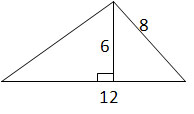All GMAT Math Resources
Example Questions
Example Question #102 : Triangles







Is 
Statement 1: 


Statement 2: 
Note: For purposes of this problem, 


EITHER STATEMENT ALONE provides sufficient information to answer the question.
STATEMENT 1 ALONE provides sufficient information to answer the question, but STATEMENT 2 ALONE does NOT provide sufficient information to answer the question.
BOTH STATEMENTS TOGETHER do NOT provide sufficient information to answer the question.
BOTH STATEMENTS TOGETHER provide sufficient information to answer the question, but NEITHER STATEMENT ALONE provides sufficient information to answer the question.
STATEMENT 2 ALONE provides sufficient information to answer the question, but STATEMENT 1 ALONE does NOT provide sufficient information to answer the question.
STATEMENT 1 ALONE provides sufficient information to answer the question, but STATEMENT 2 ALONE does NOT provide sufficient information to answer the question.
Assume Statement 1 alone. An exterior angle of a triangle forms a linear pair with the interior angle of the triangle of the same vertex. The two angles, whose measures total 





Statement 2 alone provides insufficient information to answer the question. For example, if 



















Example Question #103 : Triangles
The measures of the angles of one triangle, in degrees, are 
The measures of the angles of a second triangle, in degrees, are 
What is 
The degree measures of the angles of a triangle add up to a total of 180, so we can set up the following equations:
From the first triangle:
From the second:
These equations form a system of equations that can be solved:


and 
Example Question #104 : Triangles
The largest angle of an obtuse isosceles triangle has a measure of 

The height of the obtuse isosceles triangle bisects the 






Example Question #1 : Calculating The Area Of An Acute / Obtuse Triangle
What is the area, to the nearest whole square inch, of a triangle with sides 12, 13, and 15 inches?
None of the other answers are correct.
Use Heron's formula:
where 
Example Question #1 : Calculating The Area Of An Acute / Obtuse Triangle
Calculate the area of the triangle (not drawn to scale).

In this problem, the base is 12 and the height is 6. Therefore:
Example Question #2 : Calculating The Area Of An Acute / Obtuse Triangle

Note: Figure NOT drawn to scale.
What is the area of the above figure?
More information is needed to answer this question.
The figure is a composite of a rectangle and a triangle, as shown:

The rectangle has area
The triangle has area
The total area of the figure is
Example Question #32 : Acute / Obtuse Triangles
Which of the following cannot be the measure of the vertex angle of an isosceles triangle?
Each of the other choices can be the measure of the vertex angle of an isosceles triangle.
Each of the other choices can be the measure of the vertex angle of an isosceles triangle.
The only restriction on the measure of the vertex angle of an isosceles triangle is the restriction on any angle of a triangle - that it fall between 



Since all of these measures fall in that range, the correct response is that all are allowed.
Example Question #352 : Geometry
What is the area of the triangle on the coordinate plane formed by the 


The easiest way to solve this is to graph the three lines and to observe the dimensions of the resulting triangle. It helps to know the coordinates of the three points of intersection, which we can do as follows:
The intersection of 


The lines intersect at
The intersection of 


These lines intersect at
The intersection of 

The lines intersect at
The triangle therefore has these three vertices. It is shown below.

As can be seen, it is a triangle with base 9 and height 12, so its area is
Example Question #6 : Calculating The Area Of An Acute / Obtuse Triangle
What is the area of a triangle on the coordinate plane with its vertices on the points 
The vertical segment connecting 





Example Question #7 : Calculating The Area Of An Acute / Obtuse Triangle
Which of the following is the area of a triangle on the coordinate plane with its vertices on the points 

We can view the horizontal segment connecting 






All GMAT Math Resources























































































